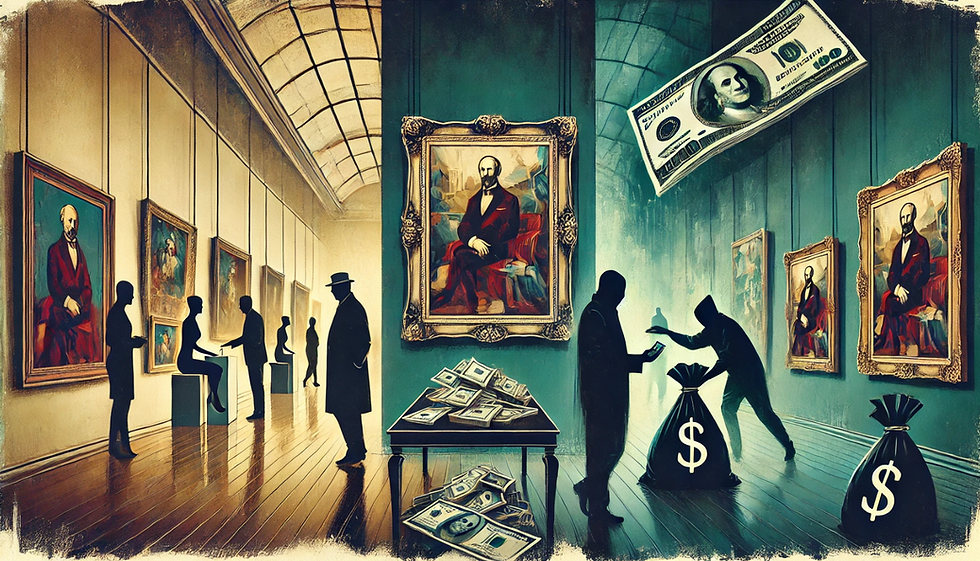An artist's rating
- jonathan-pradillon

- Nov 21, 2024
- 4 min read
In the art world, an artist’s worth is often determined by auction results, exhibitions in prestigious galleries, or reviews from well-known critics. But is this truly the best way to assess an artist’s value? Wouldn’t it be more accurate to consider the enthusiasm of private collectors as the real measure of success? This article explores an alternative viewpoint: one that places collectors and their genuine appreciation at the center of an artist's valuation, rather than the sometimes speculative mechanisms of the institutional art market.

Reframing Value: Collectors as the Key Players
An artist’s worth is often seen as a marker of prestige, shaped by record-breaking auction sales or collaborations with elite institutions. However, this approach has a significant flaw: it can be skewed by speculative strategies designed to artificially inflate an artist’s value.
The Crucial Role of Collectors in Appreciating Art
Unlike auction sales, where exorbitant prices can be achieved for purely financial reasons, purchases made by passionate collectors reflect the true interest and emotion that an artist’s work evokes. When someone invests in an artwork, it’s not just a transaction; it’s a validation of the artist and their craft.
A private collector buys an artwork because it speaks to them, resonates with their values, or aligns with their personal aesthetics. This human connection and authentic validation are the true measures of an artist’s worth.
Institutions and Auctions: Speculation and Influence
Institutions like Christie’s or Sotheby’s hold significant sway over the art market. However, their primary goal is financial gain. This creates a dynamic reminiscent of stock markets, where powerful groups manipulate values for profit. These practices often detach an artist’s worth from their genuine popularity or cultural impact.
The Limitations of the Institutional System
The current model operates within a complex ecosystem where galleries, auction houses, and critics hold the reins of an artist’s valuation. But does this system truly reflect the intrinsic value of a creator?
Speculation as the Driving Force
In many cases, the prices achieved at auctions reflect financial strategies rather than widespread admiration for the artist. Some works are purchased solely to be resold at higher prices, with little regard for their artistic or emotional value. This transforms art into a financial product, stripped of its deeper meanings.
Limited Accessibility for the Broader Public
The system of major auction houses excludes many genuine art enthusiasts, creating a barrier between artists and authentic buyers. These institutions cater to a financial elite, concentrating works in the hands of a small group of powerful buyers. As a result, emerging or independent artists struggle to gain recognition, even if their work resonates deeply with the public.
Why Collectors Are the True Arbiters of Value
If we want to establish a fairer and more representative system, we must put private collectors at the forefront. Their interest in an artist is far more significant than auction records or prestigious exhibitions.
The Authenticity of Private Acquisitions
Collectors buy out of passion, not speculation. Every purchase becomes a testament to the artist and their work. Unlike auctions, where competition and social image play a role, a private acquisition is a genuine affirmation of artistic merit.
A Purchase Beyond Finances: Collectors don’t buy artworks to resell them but to own, appreciate, and sometimes pass them down.
A Dialogue Between Artist and Buyer: Collectors often maintain direct relationships with artists, providing valuable feedback and moral support.
The Collective Power of Art Enthusiasts
When a large number of collectors invest in an artist, it signifies genuine public enthusiasm. This dynamic is far more meaningful than decisions made by a handful of critics or auctioneers. An artist’s popularity among collectors reflects their cultural influence and societal impact.
The Benefits of a Collector-Centered Model
Placing collectors at the heart of an artist’s valuation brings numerous advantages for both creators and the art market as a whole.
A More Accessible Art Market
By prioritizing private acquisitions, the art market becomes more inclusive. This allows emerging or independent artists to gain recognition and establish their reputation without relying on elitist institutions.
A More Representative Valuation
A value based on private acquisitions better reflects public tastes and preferences. It offers a fairer picture of an artist’s place in contemporary culture, emphasizing their ability to connect with people rather than their speculative financial worth.
A More Ethical Economic Model
This approach fosters a fairer relationship between artists and buyers. Instead of depending on powerful intermediaries, artists can build direct connections with their audience and receive fair compensation for their work.
Value Lies in Authenticity
Redefining an artist’s worth through the lens of private collectors brings the focus back to what truly matters: genuine appreciation for art. Purchases driven by passion, rather than speculation, are the real barometer of an artist’s value. By highlighting this aspect, we can create a more transparent, inclusive, and artist-respecting art market.
FAQ
How do collectors influence an artist’s worth?
Their purchases reflect real interest and appreciation, making them a more authentic measure of an artist’s success.
Do galleries still have a role to play?
Yes, but their role should be complementary, supporting artists and helping them reach a wider audience rather than controlling their value.
What are the risks of a collector-centered model?
One potential risk is reduced visibility for emerging artists in local networks, but digital platforms can help counterbalance this.
How can an artist strengthen their value among collectors?
By fostering direct relationships with their audience, participating in accessible exhibitions, and emphasizing the authenticity of their work.




Comments